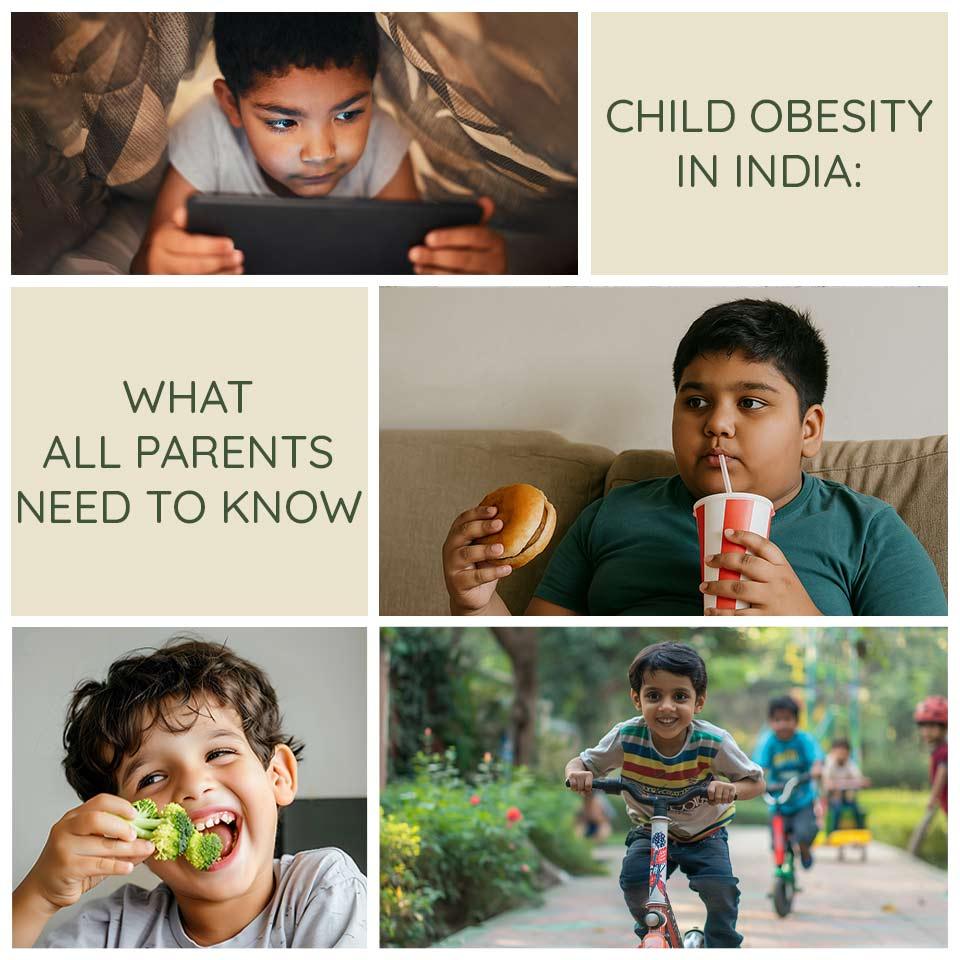
Child obesity in India: What All Parents need to Know
Obesity in children quickly becomes one of the most public health challenges in India. The modern mix of traditional Indian habits with rapidly changing lifestyles is at the center of this problem.
Let's break down the causes, what is unique to Indian homes, and most importantly, what parents can do, and what children should avoid to grow healthily.
The Alarming Reality in India
The number is shocking: India now has more than 12.5 million children between the ages of 5 and 19, a dramatic increase from just 0.4 million(1990). That one in ten children falls into a category suffering from overweight or obesity, and rates are constantly rising, especially in urban areas.
Even more, 80% of obese teenagers will probably be overweight or obese in adulthood. It translates to an increased risk of diabetes, heart disease, high blood pressure, joint problems, liver problems, and even mental health issues such as depression and low self-confidence.
Why Are Indian Children Becoming Obese?
Many factors that lie in both modern life and Indian culture contribute to this worrying trend:
• Dietary changes: Traditionally, the Indian diet is rich in vegetables and whole grains, but is replaced by fast food, processed snacks, and sugary drinks. Children tend to eat more samosas and chips, less pulses and vegetables.
• Idle lifestyle: With more screen time (TV, phone, computer), children spend less time playing outdoors. Physical activity, once an integral part of childhood in India, is now limited.
• Urbanisation: In cities, limited open areas and long school hours reduce active sports opportunities.
• Busy parents, Fast food: Many working parents, especially in urban India, find it difficult to prepare fresh food, leading children to depend on immediate food or quick-witted takeaways.
• Cultural faith: For many Indian families, a "roly-poly child" is a sign of prosperity, not a health risk. This mentality can prevent initial intercession.
• Socio-economic factors: Parents associated with high income and an idle or less active lifestyle are also correlated with obesity in children.
• Genetics and family habits: It is more likely that obese children with obese parents are not only due to genes, but also shared food and activity patterns.
What should parents do (and not)?
Parents are the foremost defense system in dealing with the obesity of children. Certain Steps can be taken to avoid difficulties:
Dos
• Model healthy habits: Children mimic parents. Eat healthy food together and make activity a family relationship - to play cricket, cycle, or play in the park.
• Serve balanced food: Priorities whole grains (millet, oats, brown rice), vegetables, fruits, pulses, and home-cooked food. Limit fried and processed food or junk food.
• Encourage physical activity: Make sure children get at least 60 minutes of physical activity with moderate to vigorous physical activity every day, such as games, sports, or even dance or garba.
• Determine the screen deadline: Limit the time spent on TV and gadgets. Encourage reading, hobbies, and outdoor games instead.
• Educate, don’t hesitate: Talk to children about health instead of appearance. Emphasize that everyone's body is different, and healthy habits are lifelong.
• Create a healthy environment: Create your kitchen with nutritious options and avoid keeping fast food within easy access.
Don'ts
• Do not use food as a reward or punishment: This can cause emotional eating and unhealthy relationships with food.
• Do not miss meals or push the diet trends: avoiding meals can slow metabolism, and the quick-fix diet is often not a good option in the long term for children.
• Do not ignore mental and emotional health: Deal, weight-related stress, anxiety, or bullying with compassion and support. Mental health is just as important as physical health.
• Do not assume that "he/she will be out of it": Obesity during childhood often persists and worsens, which causes serious complications in adulthood.
Indian lifestyle: unique challenges and solutions
• Festivals and Family get-together: Indian festivals mean a lot of sweets and snacks. Enjoy them, but in balance. Make them know about portion control without being "prohibited".
• School lunch: Prepare healthy and home cooked tiffin instead of providing packed and processed food.
• Peer Pressure: Teach children to create a healthy alternative even when their friends or classmates prefer packed and processed food.
Good practice for Indian homes
• Cook together as a family - it creates strong ties and educates children about nutritious alternatives.
• Encourage traditional physical activities: Kabaddi, Kho-Kho, Dance, Badminton, and Yoga.
• Try to plan a weekly "technology-free" day to support physical activity.
• Plant a small kitchen garden - help children nourish vegetables and fruits.
• Remain connected with teachers to make sure schools encourage active physical play and provide healthy food options.
Final thoughts
Obese children in India are more than just one medical concern - it is our culture, habits and environment shaped. Small changes never happen soon (or behind time). You can give them the best and a healthy future gifts by determining realistic goals, leading with examples, and actively participating in your child's lifestyle.
- Dt. Simran Kushwaha
(Executive Nutritionist – The Nuva)
References:
1. Medanta blog: Obesity in children in India (https://www.medanta.org/patient-education-blog/obesity-in-children-in-india#:~:text=The%20prevalence%20of%20obesity%20in,India%20are%20overweight%20and%20obese) .
2. The Lancet Study, Economic Times & NDTV (https://www.ndtv.com/india-news/12-5-million-children-in-india-obese-in-2022-up-from-0-4-million-in-1990-lancet-study-5155312)
3. SGRH: Obesity in India (https://sgrh.com/blog/obesity-in-india-a-growing-health-concern)
4. Apollo Cradle: Childhood Obesity Causes and Prevention (https://www.apollocradle.com/blog/child-care/childhood-obesity-causes-prevention-management-in-children)
